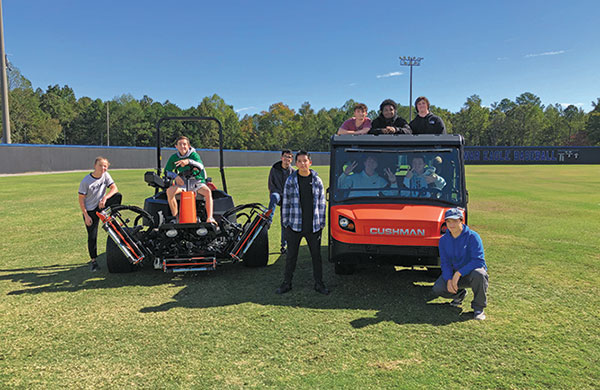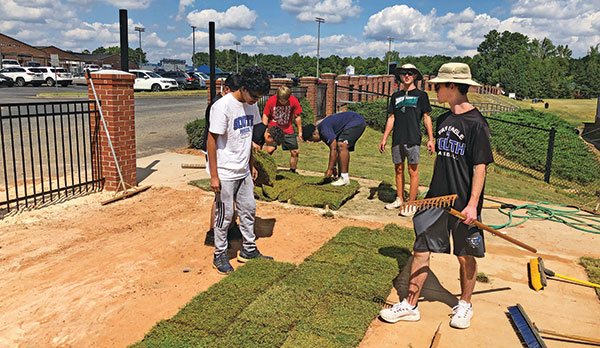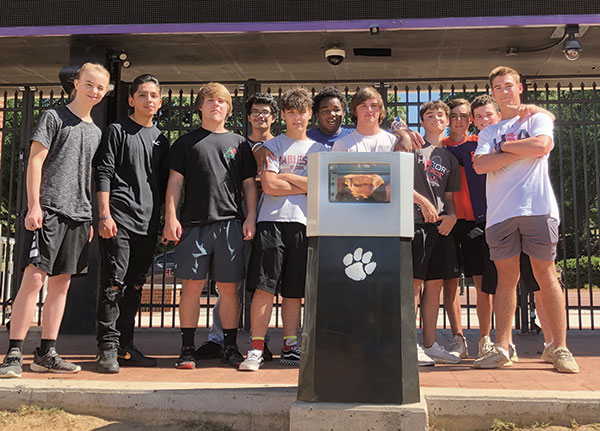Starting ’em young in the turfgrass industry

South Forsyth High School’s turfgrass program aims to introduce interested students to the turfgrass industry. (Photo: Russ Bayer)
Students interested in turfgrass management at South Forsyth High School in Cumming, Ga., already have a leg up on the competition when it comes to both turf knowledge and know-how — all thanks to the school district’s newly developed turfgrass management career path.
“We’re engaging students who have a passion for anything from golf course maintenance to the landscaping industry to athletic facilities and anything in that spectrum,” says Russ Bayer, turfgrass management instructor and head baseball coach at South Forsyth High School.
Inspired by similar programs for other professions in Georgia as well as turfgrass programs in Florida and the Midwest, South Forsyth’s turfgrass program began during the 2019-2020 school year, with much of the instruction taking place outside of the classroom.
“I wanted to do everything I can to make sure there’s a new wave of kids who come into the industry,” says Tommy Hewitt, the regional superintendent at Windermere Golf Club in Cumming, who has helped develop the program at South Forsyth. “I think a lot of people have lost sight of what the industry is and what it can be.”
A growing program
South Forsyth High School’s turfgrass management program currently has 12 students enrolled, ranging in age from ninth graders through 12th graders. The majority of them are underclassmen. Enrollment in the program for the 2020-2021 school year has nearly doubled, according to Bayer.

Students learn skills necessary in the turfgrass world in a hands-on fashion. (Photo: Russ Bayer)
Prior to enrollment, South Forsyth’s counseling staff meets with students to discuss their interests and goals. Because the high school considers the course a “career pathway,” students who live outside of South Forsyth School District but within Forsyth County also can take part in the pathway.
Throughout the next few years, the program will be flushed out to three separate, year-long courses: Turf 1, Turf 2 and Turf 3.
Turf 1 (now in its inaugural year) will introduce students to agricultural education, the Future Farmers of America, warm- and cool-season grasses, irrigation techniques and soil sciences at the grassroots level.
Turf 2 will delve deeper into the soil sciences.
The curriculum for Turf 3 may vary by students’ individual interests and will depend on what aspect of the turfgrass field they wish to pursue. The hope, Hewitt says, is that Turf 3 will take on an internship-type style.
“It will be a real-world immersion of what they’ve learned,” Hewitt says.
When the weather cooperates, Bayer says he tries to get the students outside three of the four days a week that the class meets, with one classroom session set aside for a traditional lecture-style setup.
“The first couple of months, I tried to get the kids familiar with the equipment we had from our athletic fields, to
get their hands on it, to understand and respect it, but also to see what the use of that equipment can accomplish,” Bayer says.

Many of the younger students enrolled in Turf 1 will continue the turfgrass track to complete the Turf 2 and 3 courses over the next few years. (Photo: Russ Bayer)
Hewitt adds that parts of the course focus on new technology such as GPS mapping for soil analysis and using drones to analyze a golf course.
“That’s the kind of thing we’re trying to show them, because they are of a technology age,” he says. “We’re also trying to look at things they’re learning from a perspective of not what we did 20 years ago, not what we’re doing today, but what are we going to be doing or expecting from the industry in 10 years?”
Field trips have included visits to various golf courses and athletic fields, including those at Clemson University and Auburn University.
Bayer admits that an early challenge proved to be figuring out what would hook the students and keep them interested.
“It was just keeping them active and engaged and giving them something that reflects the effort they put into it,” Bayer says. “It’s finding that balance between being in the classroom versus being outside and active.”
Upon graduation from high school and completion of the program, students will receive a Career, Technical and Agriculture Education designation on their diploma to signify that they participated in a college prep or technical prep program.
Garnering support
For other high schools interested in incorporating similar programming, Bayer suggests leaning on the turfgrass industry for help.
“Don’t be afraid to reach out to people in the turfgrass industry,” he says. “They’ve been willing to answer questions, help us out, point us in the right direction.”
Bayer says he got feedback from turfgrass programs at universities such as Penn State, Auburn and Clemson about the foundation students interested enrolling in collegiate-level turfgrass programs should have. He also sought advice from high schools in the Midwest that have similar programs already in place.
“A lot of (what they said) was just being able to speak the language and terminology, having respect for and being comfortable with the equipment and having the initiative and ability to work with each other as a team,” Bayer says.
While procuring the equipment for the class was challenging, many local manufacturers and distributors, including SiteOne and Textron, stepped up and donated thousands of dollars’ worth of equipment to the program, including a fairway mower, a trim mower, carts and an infield rake.
“The last thing I wanted in a class of 14 kids (was) for one of them to be operating a blower or weed eater and the other 13 just looking at (him or her),” Hewitt says. “I want to make sure they have as much opportunity to be doing something, not just standing around, because if they’re going to stand around, they’re not going to stay in the business.”
Bayer adds that the school district and local turfgrass community have been instrumental as well.
“It’s really gained a lot of traction,” Bayer says. “The turfgrass industry had been outstanding with helping us out, reaching out and trying to get involved and making sure we’re steering these young men and women in the right direction.”
The impact
While all the students have some interest in the turfgrass industry, Hewitt says the inaugural group is diverse in that while some students plan to attend a four-year university, others plan to attend a technical institute and still others may enter the workforce immediately following graduation from high school.
Already, Bayer adds, many of the students have had a hand in preparing for the sporting events held at the school’s athletic fields.
Additionally, Hewitt says several students from the class were hired to work at four local golf courses after school and on the weekends.
“We’re trying to give these kids an opportunity to learn about the careers that are available and work at golf courses and show them what’s in this,” Hewitt says. “Obviously, labor is an issue, but we’re also trying to help these kids make some money, stay out of trouble and create a work ethic. It’ll also help the golf courses with employees who I think are actually going to care and be interested in learning more.”










